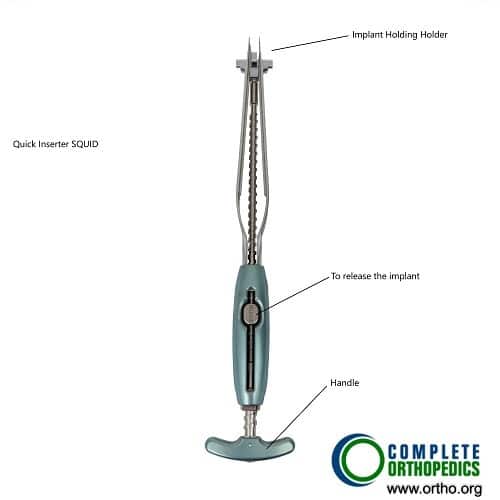Anterior Lumbar Interbody Fusion Surgery
If lumbar spine pain becomes so severe that it disrupts daily activities or is accompanied by swelling, tenderness, or redness, it’s important to seek medical attention.
At Complete Orthopedics, our expert lumbar spine specialists are adept at treating lumbar spine pain through both surgical and non-surgical methods. We examine symptoms, diagnose the condition, and recommend suitable treatments, including surgery if necessary.
Serving New York City and Long Island, we partner with six hospitals to offer cutting-edge lumbar spine surgery and comprehensive orthopedic care. You can schedule a consultation with our orthopedic surgeons online or by phone.
Learn about the common causes of lumbar spine pain and the treatment options available, including when surgery might be the best choice.
Overview
Anterior lumbar decompression surgery, specifically anterior lumbar interbody fusion (ALIF), is a specialized surgical technique used to address various spine conditions. This procedure involves fusing adjacent vertebrae from the spine’s front (anterior). During the surgery, the problematic disc material is removed and replaced with a bone graft and a cage (implant), which helps the vertebrae join naturally. ALIF can be performed alone or alongside a posterior approach to enhance stability.
Instruments Used in ALIF
The success of ALIF depends significantly on the precise use of surgical instruments. These include forceps for disc removal, bone graft cages (metal or PEEK – a type of plastic), and stabilization tools such as screws, plates, and rods. A quick implant inserter with a depth gauge and release mechanism is often utilized to ensure the accurate placement of the implants.

A quick implant inserter for ALIF with depth gauge and release mechanism.

Instruments used in ALIF
Indications for ALIF
ALIF is indicated for various spine conditions, including:
- Herniated intervertebral discs
- Traumatic anterior extradural compression
- Degenerative disc disease
- Deformity correction
- Biopsy and debridement
- Tumor management
- Lumbar disc replacement surgery
The ALIF Procedure
Patients undergoing ALIF are given general anesthesia, rendering them unconscious and unable to feel pain. The patient is positioned on a specially designed operating table with their back down.
- Incision and Exposure:
- An oblique incision is made on the left side of the abdomen.
- Abdominal muscles are split and retracted, revealing the peritoneum, a protective covering of the abdominal organs.
- The surgeon carefully retracts the peritoneum to one side, avoiding the sympathetic nerve plexus and major blood vessels, with assistance from a vascular surgeon.
- Disc Removal and Grafting:
- Special forceps are used to remove the intervertebral disc material and any structures compressing the neural elements.
- The adjacent vertebrae are distracted (gently separated) to insert a cage filled with bone graft material. The bone graft can be autologous (from the patient’s pelvic bone) or obtained from a bone bank.
- Stabilization:
- The construct is stabilized using screws and plates from the front or screws and rods from the back.
- If needed, a posterior surgery may also be performed for additional stability and decompression.
- Closure:
- The incisions are closed in layers, and a bandage is applied.
Advantages of the Anterior Approach
The anterior approach in ALIF has several benefits over the posterior approach:
- Muscle Preservation: The back muscles are not cut or separated, which is common in posterior approaches. This preservation leads to reduced postoperative pain and better muscle function.
- Avoiding Dural Manipulation: The anterior approach does not involve disturbing the dural sac (the protective covering of the spinal cord), reducing the risk of dural scarring and related complications.
- Larger Implants and Better Compression: Surgeons can place larger cages and compress the bone graft more effectively, enhancing the fusion process.
- Better Access to Pathologies: Conditions located at the front of the spine are more accessible and manageable through the anterior approach.
- Ideal for Revision Surgeries: Patients who have undergone previous posterior surgeries are often good candidates for the anterior approach, providing an alternative route for additional procedures.
Postoperative Care and Recovery
Postoperative care is crucial for a successful recovery. Patients are typically encouraged to walk on the first day after surgery. While they can resume daily activities within a few weeks, they should avoid heavy lifting and bending to allow proper healing. Most patients experience significant symptom relief within weeks of the surgery.
Potential Complications
As with any surgical procedure, ALIF carries some risks:
- Vascular Damage: The close proximity to major blood vessels poses a risk of significant bleeding.
- Organ Damage: There is a potential for damage to the peritoneum and abdominal organs.
- Nerve Damage: Male patients might experience retrograde ejaculation due to sympathetic nerve injury.
- General Surgical Risks: These include infection, nonunion of the fusion, and implant-related issues.
Despite these risks, complications are relatively rare, and most patients achieve excellent outcomes. It is essential to discuss the best surgical approach with a fellowship-trained spine surgeon to ensure optimal treatment for your specific condition.
Conclusion
Anterior lumbar interbody fusion (ALIF) is a robust and effective surgical technique for treating a range of lumbar spine conditions. By accessing the spine from the front, surgeons can avoid the complications associated with posterior approaches, such as muscle damage and dural scarring. The anterior approach allows for better placement of implants and addresses spinal pathologies more directly. With advancements in surgical instruments and techniques, ALIF offers patients a promising path to recovery, with reduced pain and improved spinal stability. As with any surgical procedure, it is crucial to consult with a qualified spine surgeon to determine the best approach for individual cases.
Do you have more questions?
What conditions are typically treated with ALIF?
ALIF is commonly used to treat conditions such as degenerative disc disease, herniated discs, traumatic anterior extradural compression, deformities, and tumors in the lumbar spine. It may also be used for lumbar disc replacement and revision surgeries.
Why is the anterior approach preferred over the posterior approach in some cases?
The anterior approach avoids cutting or separating the back muscles, leading to reduced postoperative pain and faster recovery. It also allows the surgeon to place larger cages and better address pathologies located at the front of the spine.
What are the main risks associated with ALIF?
Risks include damage to major blood vessels, potential injury to abdominal organs, retrograde ejaculation in male patients, infection, nonunion of the fusion, and implant-related issues. However, these complications are relatively rare.
How long is the recovery period after ALIF?
Patients are encouraged to walk on the first day after surgery and can usually resume daily activities within a few weeks. Full recovery, including bone fusion, can take several months, depending on individual factors and adherence to postoperative guidelines.
What types of implants are used in ALIF?
Implants typically include metal or PEEK (polyether ether ketone) cages filled with bone graft material. Screws and plates or rods are used to stabilize the construct until fusion occurs.
Is general anesthesia always required for ALIF?
Yes, ALIF is performed under general anesthesia to ensure the patient is unconscious and does not feel pain during the procedure.
Where is the bone graft material obtained from?
Bone graft material can be harvested from the patient’s pelvic bone (autograft) or obtained from a bone bank (allograft).
What postoperative care is necessary following ALIF?
Postoperative care includes early mobilization, avoiding heavy lifting and bending, and following a rehabilitation program as prescribed by the surgeon. Pain management and wound care are also important aspects of recovery.
Can ALIF be performed on patients with previous spine surgeries?
Yes, ALIF can be an excellent option for patients who have had previous posterior spine surgeries, as it provides an alternative route for accessing and treating the spine.
What is the success rate of ALIF?
The success rate of ALIF is high, with most patients experiencing significant pain relief and improved spinal stability. Long-term studies indicate sustained benefits and low complication rates.
How does ALIF compare to other spinal fusion techniques?
ALIF offers advantages such as muscle preservation, better implant placement, and more direct access to certain spinal pathologies. Compared to posterior approaches, it often results in less postoperative pain and faster recovery.
What symptoms indicate the need for ALIF?
Symptoms that may indicate the need for ALIF include chronic lower back pain, leg pain, numbness or weakness due to nerve compression, and spinal instability.
What are the alternatives to ALIF?
Alternatives include posterior lumbar interbody fusion (PLIF), transforaminal lumbar interbody fusion (TLIF), and less invasive techniques such as minimally invasive spinal fusion, depending on the specific condition and patient needs.
How does the surgeon decide between using an anterior or posterior approach?
The decision is based on the specific spinal pathology, the location and extent of disc degeneration or compression, the patient’s anatomy, and previous surgical history. A thorough evaluation and imaging studies guide this decision.
Can ALIF address multiple levels of the spine at once?
Yes, ALIF can be used to address multiple levels of the lumbar spine in a single surgery, although this depends on the patient’s specific condition and overall health.
What is the typical duration of an ALIF surgery?
The duration of ALIF surgery varies but typically ranges from 2 to 4 hours, depending on the complexity of the case and whether additional procedures (such as posterior stabilization) are performed.
What are the signs of a successful fusion after ALIF?
Signs of successful fusion include the absence of pain or significant reduction in pain, stability in the treated spinal segment, and evidence of bone growth and fusion on follow-up imaging studies.
How soon can patients return to work after ALIF?
The timeline for returning to work varies based on the individual’s job demands and recovery progress. Light-duty work may be possible within a few weeks, while more physically demanding jobs may require several months before a full return.
What are the long-term outcomes of ALIF?
Long-term outcomes are generally positive, with many patients experiencing sustained pain relief, improved function, and enhanced quality of life. Regular follow-up with the surgeon ensures monitoring of fusion progress and early identification of any issues.
Is there a risk of needing additional surgeries after ALIF?
While ALIF aims to provide a lasting solution, some patients may require additional surgeries if new spinal issues arise or if the initial fusion does not achieve the desired stability.
Can ALIF be combined with other treatments for better results?
Yes, ALIF can be combined with posterior fusion techniques or other spinal treatments, such as decompression surgery, to address complex cases and enhance overall outcomes.
How do patients manage pain after ALIF?
Pain management may involve medications, physical therapy, and other modalities such as heat/cold therapy. The surgeon will provide a comprehensive pain management plan tailored to the patient’s recovery process.
What kind of rehabilitation is involved after ALIF?
Rehabilitation typically includes physical therapy focused on strengthening the core muscles, improving flexibility, and gradually increasing activity levels. A personalized rehab plan is created based on the patient’s progress and specific needs.

Dr. Suhirad Khokhar
My name is Dr. Suhirad Khokhar, and am an orthopaedic surgeon. I completed my MBBS (Bachelor of Medicine & Bachelor of Surgery) at Govt. Medical College, Patiala, India.
I specialize in musculoskeletal disorders and their management, and have personally approved of and written this content.
My profile page has all of my educational information, work experience, and all the pages on this site that I've contributed to.
